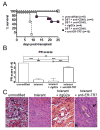Lymph Node Stromal Fiber ER-TR7 Modulates CD4+ T Cell Lymph Node Trafficking and Transplant Tolerance
- PMID: 25769074
- PMCID: PMC4452399
- DOI: 10.1097/TP.0000000000000664
Lymph Node Stromal Fiber ER-TR7 Modulates CD4+ T Cell Lymph Node Trafficking and Transplant Tolerance
Abstract
Background: Trafficking and differentiation of naive CD4+ and regulatory T cells (Treg) within the lymph node (LN) are integral for tolerance induction. The LN is comprised of stromal fibers that dictate lymphocyte migration and LN structure, organization, and microanatomic domains. Distribution of the stromal fiber ER-TR7 changes within the LN after antigenic challenge, but the contributions of ER-TR7 to the resulting immune response remain undefined. We hypothesized that these stromal fiber structural changes affect T cell fate and subsequently allograft survival.
Methods: C57BL/6 mice were left naive (untreated) or made immune or tolerant (donor-specific BALB/c splenocyte transfusion -/+ anti-CD40L monoclonal antibody), or made tolerant and received anti-ER-TR7 monoclonal antibody. Donor-specific T-cell migration was visualized by adoptive transfer of carboxyfluorescein diacetate, succinimidyl ester-labeled TEa T cell receptor transgenic CD4+ cells. Immunohistochemistry was performed on LNs to detect stromal fiber distribution, structure, CCL21 presence, and Treg and donor-specific cell location relative to high endothelial venules (HEV). Naive, tolerant, and tolerant + anti-ER-TR7 mice received BALB/c heterotopic cardiac allografts and graft survival was monitored.
Results: The ER-TR7 distribution changed after the induction of tolerance vs. immunity. Treating tolerant mice with anti-ER-TR7 altered HEV basement membrane structure and the distribution of CCL21 within the LN. These differences were mirrored by changes in the migration of naive and Treg cells within and surrounding the HEV. Anti-ER-TR7 prevented tolerance induction and resulted in allograft inflammation and rejection.
Conclusions: These results identify ER-TR7 as an important component of LN structure in tolerance and a direct target for immune modulation.
Figures



References
-
- Katakai T, Hara T, Lee JH, Gonda H, Sugai M, Shimizu A. A novel reticular stromal structure in lymph node cortex: an immuno-platform for interactions among dendritic cells, T cells and B cells. Int Immunol. 2004;16 (8):1133. - PubMed
-
- Girard JP, Moussion C, Forster R. HEVs, lymphatics and homeostatic immune cell trafficking in lymph nodes. Nat Rev Immunol. 2012;12 (11):762. - PubMed
Publication types
MeSH terms
Substances
Grants and funding
LinkOut - more resources
Full Text Sources
Research Materials

